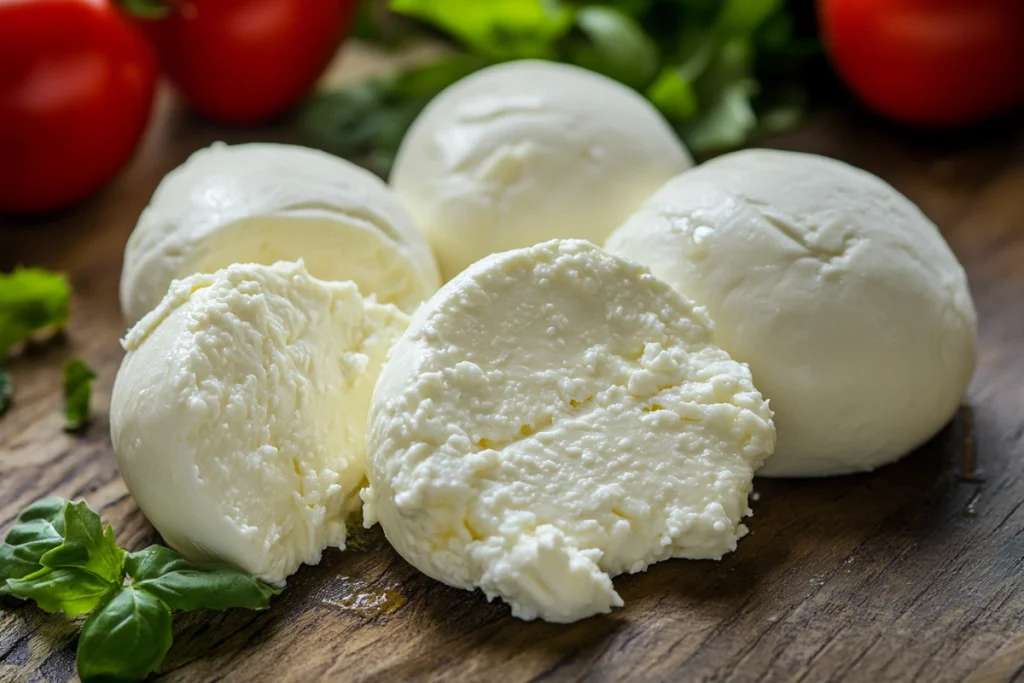Buffalo mozzarella, renowned for its creamy texture and rich flavor, is a staple in Italian cuisine. This soft cheese, traditionally made from the milk of water buffalo, has captured the hearts of cheese lovers worldwide. In this article, we’ll explore the origins of buffalo mozzarella, how it’s made, its nutritional benefits, culinary uses, and much more. Whether you’re a seasoned chef or a curious food enthusiast, this guide will help you appreciate the uniqueness of buffalo mozzarella.
Part 1: Understanding Buffalo Mozzarella
What is Buffalo Mozzarella?
When you think of Italian cheeses, mozzarella likely comes to mind. But what exactly is it? Buffalo mozzarella is a fresh cheese made primarily from the milk of the Mediterranean water buffalo. Known for its smooth, stretchy texture and mild flavor, it sets itself apart from cow’s milk mozzarella. Its unique composition results in a creamier texture, making it a favorite for various dishes, especially pizza and salads.
This cheese is often sold in a brine solution or packed in water to keep it fresh and maintain its flavor. You’ll find that its subtle taste and rich, milky notes elevate any dish it graces. But beyond just its delightful flavor, buffalo has a fascinating history and a unique production process.
History of Buffalo Mozzarella
Buffalo mozzarella hails from the Campania region in Italy, particularly from the provinces of Caserta and Salerno. The cheese’s origins date back to the 12th century, linked to the introduction of water buffalo to Italy. Farmers began using buffalo milk due to its high fat content, leading to the creation of this delectable cheese.
Over time, the production of mozzarella spread beyond Italy, gaining popularity worldwide. Today, it’s recognized for its quality, particularly when made under strict guidelines that ensure authenticity. Buffalo has even received Protected Designation of Origin (PDO) status, which guarantees its production methods and geographic origin. This designation reflects its cultural significance and commitment to traditional craftsmanship.

Part 2: The Production Process of Buffalo Mozzarella
How Buffalo Mozzarella is Made
The journey of mozzarella from farm to table is a meticulous process that showcases the art of cheese-making. It begins with the collection of fresh buffalo milk, which is known for its rich fat content—typically around 8% to 10% compared to cow’s milk, which hovers around 4%
This high fat content is a key factor in creating the creamy texture that buffalo mozzarella is famous for.
- Milk Preparation
The process starts with the milk being carefully collected and immediately cooled to preserve its quality. In many cases, it is also pasteurized to eliminate harmful bacteria while retaining its flavor
Traditional methods may still involve the use of raw milk, but strict hygiene and safety standards are upheld.
- Curdling
Once the milk is ready, it’s time for the curdling process. Rennet, an enzyme that helps coagulate the milk, is added. This causes the milk to separate into solid curds and liquid whey. The curds are then cut into small pieces to facilitate the release of more whey
- Cooking the Curds
The next step involves cooking the curds at a controlled temperature, usually around 85-90°F (29-32°C). This process helps to expel even more whey and contributes to the cheese’s unique texture
- Stretching the Curd
After cooking, the curds are drained, and the magic happens—stretching! The curds are kneaded and stretched in hot water, a process known as pasta filata. This is where mozzarella gets its signature elasticity.
The more the curds are stretched, the smoother and creamier the final product will be.
- Forming and Cooling
Once stretched, the cheese is shaped into balls or other forms, typically weighing around 125 grams each. These are then placed in cold water or brine to cool down and retain their shape.
- Packaging
Finally, the buffalo is packed in a liquid solution to keep it fresh. Many manufacturers also add a touch of salt for flavor.
The Importance of Quality Ingredients
The quality of buffalo mozzarella directly hinges on the quality of the milk used. Farmers usually graze their buffalo in lush pastures, allowing them to produce high-quality milk. In Italy, many producers adhere to strict regulations that ensure the milk comes from healthy, well-cared-for buffalo.
This emphasis on quality extends to the entire cheese-making process, where traditional techniques are often favored over industrial methods. As a result, authentic buffalo mozzarella is a product of careful craftsmanship and dedication to preserving time-honored traditions.
Part 3: Nutritional Benefits of Buffalo Mozzarella
What Makes Buffalo Mozzarella Nutritious?
When it comes to cheese, mozzarella stands out not just for its flavor but also for its nutritional profile. This cheese is not only a delightful addition to meals but also offers several health benefits that make it a great choice for many diets.
- High in Calcium
Buffalo mozzarella is an excellent source of calcium, which is vital for bone health. Just a small serving can contribute significantly to your daily calcium intake. This mineral is essential for maintaining strong bones and teeth, making it particularly important for growing children and aging adults. - Rich in Protein
For those looking to boost their protein intake, mozzarella is a fantastic option. A 100-gram serving typically contains about 22 grams of protein, making it a high-quality protein source . Protein is crucial for muscle repair, immune function, and overall growth. - Contains Healthy Fats
While buffalo mozzarella is higher in fat than many other cheeses, it mainly consists of healthy fats, particularly monounsaturated fats. These fats can help lower bad cholesterol levels and promote heart health . The fat content also contributes to the creamy texture that makes this cheese so enjoyable. - Vitamins and Minerals
In addition to calcium and protein, buffalo mozzarella is rich in several essential vitamins and minerals, including vitamin B12, phosphorus, and zinc . Vitamin B12 is vital for nerve function and the production of red blood cells, while phosphorus plays a role in energy production. - Lower in Calories Than Some Cheeses
Despite its rich flavor and creamy texture, buffalo mozzarella can be lower in calories than other cheese varieties, such as cheddar or gouda. This makes it a suitable option for those looking to manage their weight while still enjoying flavorful foods .
Comparing Buffalo Mozzarella to Cow’s Milk Mozzarella
While both buffalo and cow’s milk mozzarella have their benefits, there are notable differences:
- Fat Content: Buffalo mozzarella generally contains more fat and, consequently, more calories compared to cow’s milk mozzarella. This results in a creamier texture, which some people prefer .
- Flavor Profile: Buffalo mozzarella boasts a richer, more complex flavor due to its higher fat content. Many people describe it as creamier and more buttery than its cow’s milk counterpart .
- Nutritional Value: mozzarella typically has higher protein and calcium content, making it a more nutrient-dense option .

Part 4: Culinary Uses of Buffalo Mozzarella
Delicious Ways to Incorporate Mozzarella into Your Meals
Buffalo mozzarella isn’t just a treat for your taste buds; it’s also incredibly versatile in the kitchen. Its rich, creamy texture and unique flavor can elevate a variety of dishes. Here are some mouthwatering ways to use mozzarella:
- Caprese Salad
This classic Italian salad features fresh buffalo mozzarella, ripe tomatoes, and basil. Simply slice the mozzarella and tomatoes, layer them on a plate, and drizzle with extra virgin olive oil and balsamic vinegar. The creaminess of the buffalo mozzarella perfectly complements the freshness of the tomatoes, making it a refreshing appetizer. - Pizza Topping
Who doesn’t love a good pizza? Buffalo melts beautifully, creating a gooey, stretchy cheese topping that’s perfect for any pizza. Whether you’re making a margherita pizza or a gourmet pie with fresh veggies, using buffalo mozzarella will enhance the flavor and texture of your dish. For those wondering about combinations, try it on a white pizza with garlic and spinach
- Pasta Dishes
Adding mozzarella to pasta dishes can take your meal to the next level. Try tossing some fresh mozzarella into a creamy pasta sauce or melting it over baked pasta. The cheese’s richness adds depth to simple dishes like spaghetti with marinara sauce, transforming them into something truly special.
- Sandwiches and Paninis
Buffalo mozzarella can elevate your sandwiches and paninis. Pair it with roasted vegetables, fresh greens, or cured meats for a delightful lunch. The creamy texture of the mozzarella adds a satisfying mouthfeel that complements the crunch of the bread.
- Gratins and Bakes
Incorporating mozzarella into gratins and baked dishes creates a delicious, bubbly top. Whether in a vegetable bake or a cheese lasagna, it adds a luxurious creaminess that’s hard to resist.
- Soups
For a twist on traditional soups, try adding mozzarella to tomato soup or minestrone. The cheese melts beautifully, enriching the soup and creating a hearty texture.
Mozzarella on Pizza: The Star Ingredient
Among all its uses, buffalo mozzarella is especially beloved as a pizza topping. It melts better than many other cheeses, resulting in that perfect gooeyness that makes pizzas irresistible. Many pizzerias in Italy use mozzarella as a standard ingredient, giving their pizzas a distinct flavor that sets them apart from those topped with regular mozzarella.
Moreover, its moisture content means that you should be careful not to overload your pizza with it; otherwise, you might end up with a soggy crust. To combat this, consider draining the mozzarella and patting it dry before adding it to your pizza.
Creative Pairings for Buffalo Mozzarella
If you want to get a little adventurous, consider these creative pairings:
- Fruits: mozzarella pairs wonderfully with fruits like figs, peaches, or watermelon. Try wrapping slices of mozzarella with prosciutto and serving it alongside fresh fruits for a delightful appetizer.
- Herbs: Fresh herbs like basil, mint, or oregano can enhance the flavor of buffalo mozzarella. Mix chopped herbs into a salad or sprinkle them over your dishes for a fresh touch.
- Spices: A sprinkle of crushed red pepper or black pepper can add a kick to the creaminess of the cheese, balancing flavors beautifully.
Part 5: How to Select, Store, and Serve Mozzarella
Selecting the Best Buffalo Mozzarella
When it comes to buying mozzarella, quality matters. Here’s how to ensure you’re getting the best cheese:
- Look for Authenticity
Authentic buffalo mozzarella is made from the milk of water buffaloes and is often labeled as “Mozzarella di Bufala.” If possible, check for a certification seal indicating it meets traditional production methods. This ensures you’re enjoying the true flavors of this specialty cheese . - Check the Packaging
Fresh mozzarella is usually sold in liquid or brine. If it’s vacuum-sealed, ensure it’s well-sealed and has a good shelf life. Always check the expiration date. Fresh mozzarella should have a soft, smooth texture, and it should feel slightly squishy when pressed. - Smell the Cheese
Fresh mozzarella has a mild, slightly sweet aroma. If you notice a strong or sour smell, it’s likely past its prime, and it’s best to avoid it. - Texture Matters
When you slice into mozzarella, it should have a creamy texture that oozes slightly. It shouldn’t be overly firm or dry; otherwise, you might not get that delightful stretch and creaminess that mozzarella is known for .
Storing Buffalo Mozzarella
Proper storage is essential to maintain the freshness of buffalo mozzarella:
- Keep It in Liquid
If you buy mozzarella in brine, keep it submerged in the liquid until you’re ready to use it. This helps maintain its moisture and flavor. If it’s sold in a vacuum-sealed package, keep it in the refrigerator until you’re ready to open it. - Use Airtight Containers
Once opened, store leftover mozzarella in an airtight container in the fridge, ideally in a bit of the brine or water. If that’s not possible, wrap it in plastic wrap to prevent it from drying out. - Short Shelf Life
Fresh buffalo mozzarella typically lasts about a week in the refrigerator. If you need to store it longer, consider freezing it. While freezing might alter the texture, it can still be used in cooked dishes .
Serving Mozzarella
To enjoy buffalo mozzarella at its best, consider the following serving tips:
- Room Temperature
For maximum flavor, allow mozzarella to come to room temperature before serving. This enhances its creamy texture and rich taste. - Pairings
Serve mozzarella with complementary flavors. A drizzle of high-quality olive oil and a sprinkle of sea salt can elevate its natural flavors. You can also add fresh basil or a balsamic reduction for extra zing. - Plating Suggestions
Arrange slices of buffalo mozzarella alongside heirloom tomatoes and fresh basil for a classic Caprese salad. For a more elaborate presentation, layer it with prosciutto, arugula, and a balsamic glaze on a charcuterie board. - Cooking with Buffalo Mozzarella
When using mozzarella in cooked dishes, add it toward the end of the cooking process. This helps preserve its creamy texture and prevents it from becoming rubbery .

Part 6: FAQs About Buffalo Mozzarella
Buffalo mozzarella is a beloved cheese, but many people have questions about its use, storage, and more. Below, we’ll address some frequently asked questions about this delicious cheese.
1. What Is the Difference Between Buffalo Mozzarella and Cow’s Milk Mozzarella?
Buffalo mozzarella is made from the milk of water buffaloes, while most mozzarella is made from cow’s milk. This difference significantly affects the flavor and texture. mozzarella is creamier, richer, and often has a slightly tangy taste compared to its cow’s milk counterpart. It also has a higher fat content, making it ideal for certain dishes, like pizzas and salads
2. Can You Freeze Buffalo Mozzarella?
Yes, you can freeze buffalo mozzarella, but it’s important to note that freezing may alter its texture. While it might not have the same creamy consistency after thawing, it can still be used in cooked dishes like lasagna or pizza . To freeze, wrap the mozzarella tightly in plastic wrap, then place it in an airtight container or freezer bag to prevent freezer burn.
3. How Long Does Buffalo Mozzarella Last?
Fresh mozzarella is best consumed within a week of opening, but if stored properly in liquid, it may last a bit longer. Unopened packages typically have a longer shelf life, so always check the expiration date
Once it has been opened, store it in the refrigerator submerged in its brine to maximize freshness.
4. Is Buffalo Mozzarella Lactose-Free?
While mozzarella is lower in lactose than some other cheeses, it is not completely lactose-free. People who are lactose intolerant might find it easier to digest than other cheeses, but it’s still best for them to consult with a healthcare provider .
5. What Dishes Can I Make with Buffalo Mozzarella?
Buffalo mozzarella is incredibly versatile! Here are some popular dishes you can create:
- Caprese Salad: Layer fresh mozzarella with tomatoes and basil, drizzling with olive oil and balsamic vinegar.
- Pizzas: Use buffalo mozzarella for a rich and creamy topping that melts beautifully.
- Pasta Dishes: Incorporate it into baked pasta dishes, adding it towards the end of cooking to maintain its texture .
6. What Is the Best Way to Enjoy Buffalo Mozzarella?
Buffalo mozzarella is best enjoyed fresh. Slicing it and letting it sit at room temperature for about 30 minutes before serving enhances its flavor and texture. Pairing it with ripe tomatoes, fresh basil, and a drizzle of quality olive oil makes for a delightful appetizer or side dish
Conclusion: The Delight of Buffalo Mozzarella
Buffalo mozzarella is more than just a cheese; it’s a culinary experience steeped in tradition and flavor. Made from the milk of water buffaloes, this Italian delicacy offers a creamier, richer taste compared to its cow’s milk counterpart. Its unique characteristics make it perfect for a variety of dishes, from classic Caprese salads to gourmet pizzas.
Throughout this article, we’ve explored what mozzarella is, how it’s made, and its myriad uses in the kitchen. Whether you’re a seasoned chef or a casual cook, incorporating this cheese into your meals can elevate your culinary creations to new heights.
Remember: The key to enjoying buffalo mozzarella is to serve it fresh and at room temperature, allowing its flavors to shine. So, the next time you’re in the grocery store, don’t hesitate to pick up a ball of mozzarella. You won’t be disappointed!
To delve deeper into the world of mozzarella and learn more about its health benefits, culinary uses, and more, check out resources like the USDA Food Safety and Inspection Service and the European Commission’s official website on food products. Happy cooking!

